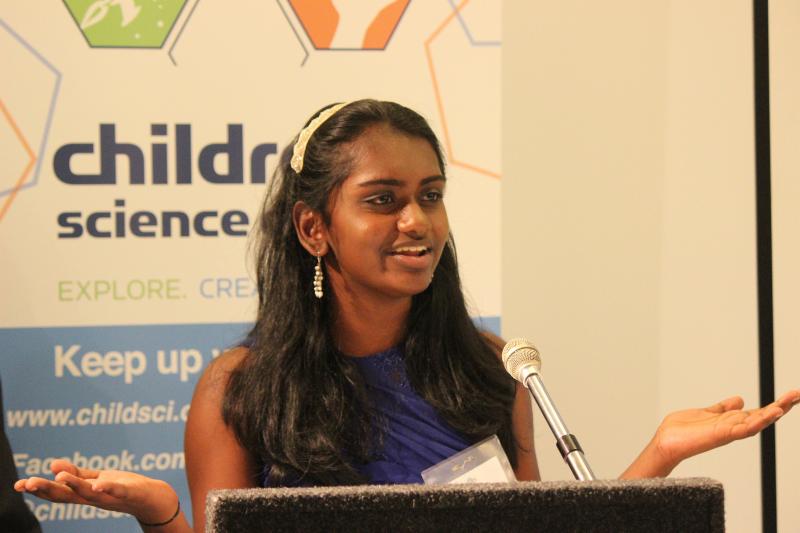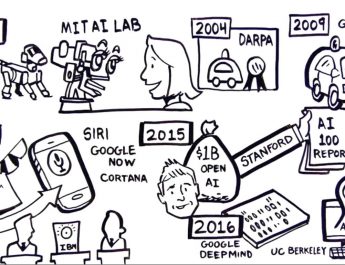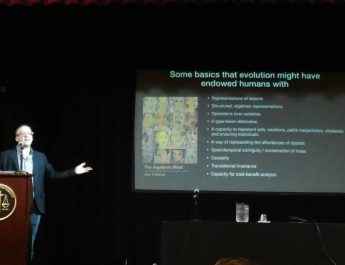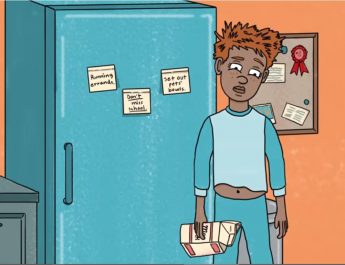Millions of patients live in rural or developing areas where disease treatment isn’t the problem: it’s overcoming the 1:1,000 doctor to patient ratio and screening for preventable diseases. High school student Kavya Kopparapu shares the future of artificial intelligence in this field– as a substitute for doctors in these areas to deliver much-needed medical diagnoses.
“In my artificial intelligence class in the fall, I taught a computer how to play the game a solo. Not only did I teach it how to play, I taught it to play well and it could be any student in my class. The funny thing is I’ve only played a fellow once in real life. I would like to ask you like how hard would it be to teach a computer how to play something that you’ve never learned before and the answer is actually very simple..”
ARTIFICIAL INTELLIGENCE
Artificial intelligence is all about taking a lot of information and presenting it to a computer and having that computer make a conclusion.
Artificial intelligence isn’t just about teaching a computer how to play a game like a fellow or chess or jeopardy. It’s about applying it in the real world like Google smart cars or Netflix is movie recommendations or series voice recognition software.
One of the most important applications of artificial intelligence is in medicine in saving lives.

Consider the human genome.. It’s 3 billion base pairs long and consisting of A’s C’s T’s and G’s. There’s a lot of natural variation in this data set.. If you take my human genome and compared to anyone else in the audience, you’ll see that we have 99.5 percent of our genome in common which means that we have 15 million base pairs that are different.
15 MILLION BASE PAIRS DIFFERENT
I wouldn’t want to go sifting through all these base pairs but that’s a task that is actually being dealt with today.
What are these 15 million base pairs? Which one makes me more predisposed for genetic disorder than the general population?
That’s what artificial intelligence researchers are trying to answer today.
Consider this researcher.. he has a database of thousands of patients, their genomes and their medical diagnoses. Now given a pencil and paper and all of the time in the world, anyone could sit and compare each genome to each other and then look for the differences that are common against all of these different disorders. But nobody has all the time in the world and it would be a pain to write this all down.
So what do we turn to? We turn to computers. Because, computers offer us a lot of valuable information that wouldn’t be possible just 15-20 years ago.
There is a better way. It’s artificial intelligence and specifically computational pathology.
COMPUTATIONAL PATHOLOGY
OBJECTİVE
TIME EFFICIENT
APPLICABLE IN THE REAL-WORLD
NO SPECIAL EQUIPMENT
Computational pathology involves taking raw medical data whether that be laboratory data or images and taking that information presenting it to a computer and getting a diagnosis.
And so computational pathology is advantageous for a few reasons. The first one is that computers are very objective meaning that if you give them a certain data, no matter what the conditions are they will always give you the same output. It’s not like humans who get tired after sifting through many patients.
Computers are also very time efficient. So in the time, it could take a human doctor to diagnose ten patients a computer could diagnose thousands of patients and these are the two reasons that make computational pathology and computer aided diagnosis very applicable in the real world. This means in developing countries or rural areas where patients don’t have access to a doctor or a diagnosis.
Computers could be used in their place. Finally one of the most unique things about computational pathology and artificial intelligence in general is that it requires no special equipment other than a reasonably capable computer.
A lot of the software is online and open source meaning that it’s free. It allows high school students like myself to be able to teach a computer to do something that we don’t know how to do well ourselves. It allows high school students to make a difference in the world however small and continue to build on that difference in our careers.
My own research in this field involves finding a quicker, cheaper, and more accurate way to diagnose diabetic retinopathy. Diabetic retinopathy is a condition in which high blood sugar from diabetes damages the blood vessels in the retina. It’s actually one of the hardest diseases to diagnose in its early stages so I can show you a little how why it’s so hard to diagnose.
DIABETIC RETINOPATHY
Consider these two images.. and these are images of actual patients retinas. I can tell you that one of the images is diabetic retinopathy positive and one is diabetic retinopathy negative..

To me, besides the color I don’t see any difference. To the untrained eye, there is no difference. But there are very small differences such as micro aneurysms or haemorrhages that are present in one of these images. That’s what makes the image diabetic retinopathy positive.
That’s why diabetic retinopathy is so hard to diagnose. Because of these small changes, it’s the leading cause of preventable blindness in the world.
That’s also why it’s so perfect for computer aided diagnosis. Because computers can easily have the computational power to be able to look for all those small changes.. Changes that it would take a human doctor hours to find.
My team and I used one of the most innovative developments in artificial intelligence technology today.
ARTIFICIAL NEURAL NETWORKS
“Neural networks are kind of like the human brain in that they take nodes or neurons connect them together and through millions of these neurons you eventually reach one output a diagnosis. In this diagram, you can see that there are a lot of different parallels between the the way the human brain processes information and the way an artificial neural network processes information.”
“I would like to conclude this talk by talking about the future. The future: I envision for artificial intelligence. I envision a future of advancements in computational pathology.. A future where a diagnosis is available to anybody, regardless of where they live, the availability of doctors, money, or even electricity. I envision a future where patients will know definitively what genetic disorders that they are predisposed for and can take charge of their own future. I envision a future in which we can save lives.”

Kavya Kopparapu is the Founder and CEO of GirlsComputingLeague and current junior at Thomas Jefferson High School for Science and Technology. She is dedicated to sharing her passion for computer science with others, especially young girls, as the field has given her a world of opportunity, and has been recognized by organizations such as the White House and the National Center for Women in Information Technology (NCWIT).
Her journey with computer science began in elementary school, when she was introduced to the Scratch programming language and developed robots using the Mindstorms programming language. Her interests were further strengthened when she took AP Computer Science in freshman year, followed by classes like Artificial Intelligence and Computer Vision.




